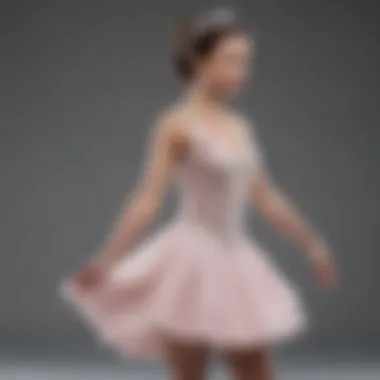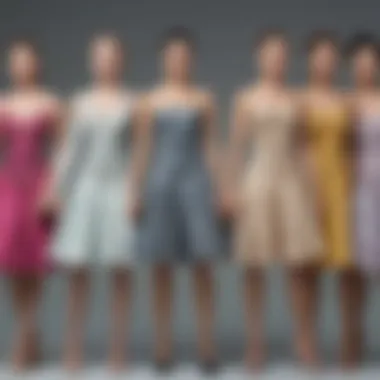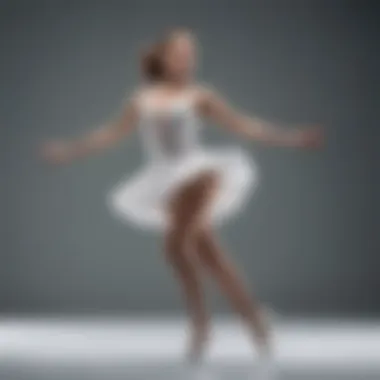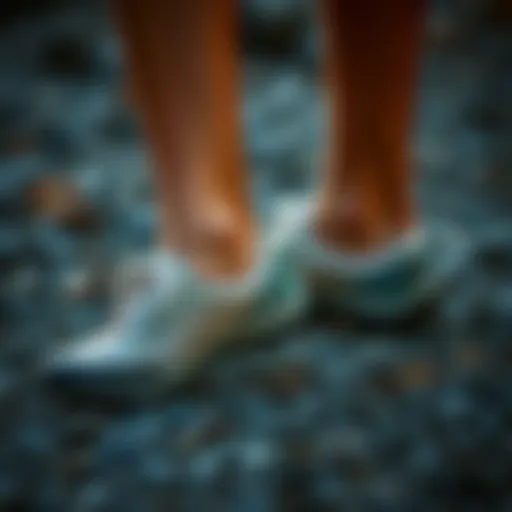The Evolution and Significance of Women's Figure Skating Dresses


Intro
The world of women's figure skating dresses is a spectacular blend of artistry and athletic prowess. These dresses are much more than mere garments; they are vital to the identity of skaters, conveying not just the grace required on the ice but also the personal style of each athlete. When a skater glides across the rink, her dress carries a message—not only about her performance but also about the evolving cultural narrative surrounding women in sports.
From the heavily embellished gowns of the early 20th century to the sleek, modern designs we see today, women's figure skating dresses have traversed a fascinating journey of evolution. The significance of this attire goes beyond the visual; it reflects shifts in societal attitudes towards women, sports, and fashion. As figure skating flourished, so did the styles of dresses, responding to both technological advancements in materials and changing trends in women's fashion.
Preamble to Figure Skating Attire
Understanding figure skating attire goes beyond just aesthetics; it encapsulates a fusion of historical evolution, cultural symbolism, and the sport's inherent blend of art and athleticism. As garments that serve both functional and expressive purposes, skating dresses are more than just beautiful costumes; they act as a crucial element in the performance of the skater.
This section highlights the interplay of design and functionality, setting the stage for the discussion about the specific elements that contribute to the evolution of women's figure skating dresses. Knowing about the history of these outfits helps one appreciate not just their beauty but their significance in the sport.
The Historical Context of Figure Skating Dresses
Historically, the attire worn by figure skaters has undergone numerous transformations since the inception of the sport. In the early days of figure skating, women typically donned long skirts or dresses that were both loose and flowing. These garments, while elegant, often hindered performance. It’s almost amusing that what was considered fashionable back then turned out to be a skater’s worst enemy in terms of functionality.
However, the real turning point came during the mid-20th century when skaters began to advocate for shorter and more fitted designs. Competitions started to showcase an increasing emphasis on athletic performance, compelling designers to rethink the traditional silhouette. The introduction of synthetic fabrics, which allowed for better flexibility and comfort, marked a significant shift in dress construction. Suddenly, skaters had options that were not only visually stunning but also allowed them to soar through the air with ease.
The Cultural Significance of Skating Dresses
Diving into the cultural implications of skating dresses reveals how these garments reflect broader societal attitudes towards women and sports. For instance, in the mid-1900s, figure skating was often viewed as a pastime for the elite. The dresses often embodied grace and femininity, adhering to conventional standards of beauty. However, as the sport evolved and became more inclusive, the attire started showcasing a wider range of styles and silhouettes.
Notably, the cultural significance of skating dresses also lies in their ability to convey identity and artistry. Skaters use their outfits to tell a story, a theme that resonates with their performance on ice. Whether opting for a classic look inspired by the elegance of ballet or diving into more avant-garde designs that break away from tradition, each dress contributes to the narrative presented on the ice.
Through the lens of cultural appreciation, these dresses have become symbols of empowerment. Increasingly, female skaters are not just judged by their skills but also by how they choose to represent themselves through their attire. As a result, skating dresses serve as an intersection between personal expression and competitive sport, echoing changes in societal values and perceptions of femininity in athletics.
Design Elements in Figure Skating Dresses
The design elements in figure skating dresses play a crucial role in the performance and image of the skater. Selecting the right combination of materials, colors, and cuts not only enhances aesthetics but also impacts functionality on the ice. The synergy of these elements can help a skater express both artistry and technical skill, creating a visually captivating experience for the audience.
Materials Used in Modern Dresses
Fabric Innovations
Fabric innovations are at the forefront of modern figure skating dress design. The importance of these advancements lies in their ability to meld fashion with utility. Materials like lightweight, moisture-wicking fabrics enable skaters to stay comfortable and agile while performing intricate moves. For instance, nylon blends often possess a unique stretchability, allowing for flexibility without the risk of tearing. This flexibility ensures that as the skater glides and spins, the dress moves seamlessly with their body, creating a harmonious flow.
That's why innovative fabrics are a hit! They allow for more intricate designs without compromising on performance. The downside sometimes is the cost; high-tech fabrics can put a dent in a budget. However, many find the investment well worth it for the benefits they bring.
Sustainability in Skating Wear
In recent years, there's been a growing awareness of sustainability in skating wear. Eco-friendly materials have started to make their mark, bringing a fresh perspective to traditional dress designs. Options made from recycled polyester or organic cotton not only reduce environmental impact but also appeal to a demographic that values ethics in fashion. The use of such materials often features in discussions around new collections, as designers recognize the importance of sustainability.
Some challenges do arise, though. While these sustainable materials are gaining popularity, they can sometimes lack the same performance qualities as synthetic fabrics, like stretch and durability. The balance between eco-conscious choices and performance can sometimes be a delicate dance.


Color Theory and Visual Impact
Color selection in figure skating dresses significantly influences the perception of a performance. It’s essential as colors can communicate emotions and themes that resonate with the audience. Designers strategize color combinations, employing color theory to evoke particular reactions or support the narrative of the routine.
Symbolism of Colors
Colors carry a wide array of meanings and resonate differently across cultures. For example, red might symbolize passion and energy, while blue can represent calmness and poise. This symbolism plays an integral part in a skater's choice of dress, aligning the outfit with their performance’s emotional undertones.
One fascinating trait of color symbolism is its capacity to enhance storytelling. If a dancer opts for a green dress, it may signify growth or renewal, complementing a performance piece conversing themes of nature. However, choosing the wrong color can lead to mixed messages during a performance.
Psychological Effects on Audience
The psychological impact of color extends to the audience’s reception. Research suggests that certain colors can affect viewers' moods and perceptions. Bright hues like yellows and pinks can create an energetic and uplifting ambiance, while darker shades might drive a more somber or intense reaction.
When skaters consider audience perception, they strive for a color palette that aligns their performance with intended emotional responses. Though the psychological aspect can be a powerful tool, it’s important to note that audience reactions can be subjective; what works for one may not hit the mark for another.
Styles and Cuts
The cut and style of a skating dress often reflects broader fashion trends, moving beyond technical apparel into realms of artistic expression. In figure skating, the interplay between traditional cuts and modern styles shapes not only the silhouette but also the practical aspects of the dress.
Flare and Fitted Designs
Fitted designs have become increasingly popular, emphasizing the skater's physique while allowing for ease of movement. Conversely, flare cuts add drama with flowing fabric that captures attention during spins and jumps. What’s interesting is how both styles cater to different aspects of performance. Fitted dresses can boost the skater's appearance of strength, while flared styles enhance the visual spectacle. However, too much flare can be problematic, as it risks catching on blades or causing snags during intricate footwork.
Influences from Other Dance Forms
Influences from various dance forms have enriched the diversity of skating dress designs. Ballet-inspired pieces, for example, often incorporate layered tulle or dramatic necklines, reflecting a fusion of grace and athleticism. This cross-pollination of styles fosters creativity, resulting in unique outfits that stand out on the ice.
While integrating elements from other performance styles offers fresh ideas, it can sometimes lead to confusion regarding identity. A dress that borrows too heavily from ballet may unintentionally overshadow the skater’s unique style, muddling the thematic focus of their performance.
In summary, the design elements of figure skating dresses encapsulate much more than mere aesthetics; they intertwine with the skater's performance, their identity, and audience engagement. A thoughtful approach to materials, colors, and styles deepens the connection between the skater and their art, culminating in a true celebration of creativity on ice.
The Role of Functionality in Dress Design
The functionality of dresses in figure skating plays a pivotal role that extends beyond mere aesthetics. As skaters twirl and glide, their attire must facilitate both freedom and safety. When a dress is designed effectively, it aligns with the movements required, allowing skaters to execute their routines effortlessly while minimizing the risk of mishaps.
Freedom of Movement
Importance of Technical Fabric
Technical fabrics show up time and again as a critical aspect of modern skating attire. Unlike standard garments, these specially engineered materials prioritize flexibility, breathability, and stretchability. For instance, fabrics like lycra and spandex are commonly used because they hug the body yet allow for maximum range of motion. This is crucial for jump sequences and spins, where skaters push their bodies to the limit.
On top of that, the moisture-wicking properties of these fabrics can help keep athletes dry by pulling sweat away from the skin, which is essential during grueling practices or performances. The lightweight nature of technical fabric minimizes bulk, ensuring that the skater's movements remain fluid and unrestrained without any added weight dragging them down.
Design Features Supporting Mobility


Designs in contemporary skating dresses also incorporate specific features aimed at improving mobility. Elements like cut-outs, mesh panels, and asymmetric hemlines let a skater showcase their artistry without compromising comfort. These features not only emphasize unique style but also contribute to a more unrestricted range of motion during performances.
For example, contrast stitching and bias-cut panels are smart design choices. They provide structure while still allowing for flexibility—creating a breathtaking visual effect as the dress flows with the motion of the skater. Additions like adjustable straps or elastic waistbands further enhance fit and security. The result is a dress that seems to dance along with the skater, reinforcing the symbiotic relationship between attire and performance.
Safety Considerations
Impact of Dress Design on Performance
The design of a skating dress effectively influences performance quality. A poorly designed dress can weigh down a skater or become a hindrance during jumps and spins, leading to compromised routines and possible injuries. For example, a heavy or excessive amount of embellishments can throw off balance or cause discomfort.
Conversely, a well-constructed dress ensures that performers are not just visually captivating but also capable of delivering technical brilliance. This harmony enables the skater to feel confident, freeing them to focus entirely on their routine, rather than on the limitations of their clothing. As an added advantage, designs that contour closely to the body can help in maintaining warmth, a subtle but notable factor in outdoor competitions.
Risk of Tangling or Snags
Last but not least, every skater knows the potential risks of entanglement or snags. With flowing skirts and elaborate embellishments, both safety and performance can be compromised if a dress isn’t constructed with care. Designers need to consider these factors during the creation process.
Using flat seams and avoiding excessive seams or trims can significantly reduce the chances of unwanted tangles while ensuring that the dress remains practical yet beautiful. A streamlined design that’s less prone to snagging not only preserves the integrity of the costume but also allows skaters to maintain focus on their performance, especially during intricate footwork or high-speed moves.
The interplay of functionality and aesthetics in women's figure skating dresses reveals the sophistication of design in the sport, proactively addressing the demands placed upon athletes.
Overall, the role of functionality can't be overlooked. It represents the fine balance between expressing artistic style and ensuring that performance isn’t compromised. Skaters need to feel liberated in their attire while maintaining a level of safety that allows for the ambitious choreography that modern routines demand.
Fashion Trends in Figure Skating Dresses
Fashion trends in figure skating dresses are not just about looking good on the ice; they signify the sport's evolution and reflect societal changes. This section discusses how trends in design, fabric, and style impact the overall performance and perception of female skaters in competitive settings as well as exhibitions.
Influential Designers and Their Impact
When we think of figure skating dresses, we often recall the stunning creations by influential designers who have shaped the landscape of skating fashion. Designers such as Vera Wang and Elsa Schiaparelli have made significant contributions by blending classical aesthetics with modern flair. Their designs often incorporate unique patterns, intricate embellishments, and innovative cuts, which elevate a skater's performance to new heights.
A case in point is the work of Vera Wang, who has crafted dresses for high-profile skaters like Michelle Kwan. Wang's designs are characterized by a balance of structure and femininity, allowing for graceful movements without sacrificing functionality. The choice of fabrics used in her dresses also plays a crucial role—lightweight yet durable materials help in both comfort and look. Similarly, designers like Yuna Kim's choice of glamorous yet practical outfits have changed how we perceive the attire worn on the ice.
The impact of these designers goes beyond mere aesthetics. Their creations often set trends that resonate, influencing younger designers and even mainstream fashion. Skaters and audiences alike come to anticipate certain styles and innovations that debut each season. For instance, some designers have ventured into sustainable fashion, using eco-friendly fabrics that reflect contemporary concerns about the environment. This not only enhances the visual appeal but also aligns with broader societal values, making the designs feel relevant beyond the rink.
Celebrity Influence in Skating Fashion
Celebrities have a potent impact on fashion trends, and figure skating is no exception. High-profile skaters become trendsetters in their own right, sparking the interest of both the general public and aspiring designers. Stars like Tonya Harding and Gracie Gold have not only wowed audiences with their performances but also with their striking outfits.
The connection between a skater's persona and their outfit can be quite telling. When Gracie Gold burst onto the scene in a dress that caught the eye with its bold colors and intricate beading, it wasn't just an outfit; it represented a fresh perspective on what a figure skater could embody—vibrant, powerful, and distinct. This influence creates a ripple effect, where fashion enthusiasts draw inspiration from successful skaters, and retailers create lines catering to this demand.
Moreover, social media platforms amplify the reach of these trends, as fans and commentators share their thoughts on outfits. Skaters share behind-the-scenes looks at their dress fittings and the design process, engaging with their audience in ways that were unimaginable in the past. Fans no longer merely watch performances; they analyze the designs and styles, elevating the fashion aspect of figure skating into a communal conversation.
In summary, the intersection of fashion and figure skating illustrates a narrative where design impacts performance, athleticism meets artistry, and societal values shape the wardrobe of female skaters. The journey from simple, functional attire to stunning representations of personal style showcases what is at stake—not just a place on the podium, but an enduring legacy in the dynamic world of figure skating fashion.
The Future of Women's Figure Skating Dresses


As we look ahead, it’s clear that women’s figure skating dresses are poised for an exciting transformation. The intersection of fashion, technology, and performance is creating new opportunities for innovation that cater to both aesthetic desires and functional requirements. With the sport continually evolving, the dresses worn by competitors are set to reflect not just personal style but also advancements in materials and techniques.
Emerging Trends to Watch
In this next chapter for figure skating apparel, some trends stand out. Firstly, eco-consciousness is driving designers to think critically about material sourcing and production techniques. Sustainable fabrics, which minimize environmental impact, are becoming increasingly sought-after. Skaters are not only athletes but also role models, and their fashion choices can inspire a movement toward responsible design.
Another trend worth noting is the rise of bold, expressive patterns. Rather than the traditional muted palettes, we see vibrant colors and unique prints gaining traction. This shift allows skaters to embody their personalities on ice, showcasing individuality and creativity. Filters of traditional norms are dissolving, paving the way for fresh styles that resonate with today's audiences.
Integration of Technology in Design
One cannot ignore the pervasive influence of technology in shaping the future of skating dresses. Designers are now incorporating smart technologies to offer skaters advantages that go beyond mere aesthetics.
Smart Fabrics and Wearable Technology
Smart fabrics, an emergent concept, are designed to meld function with fashion. These materials have the ability to adapt to temperature changes or moisture levels, keeping skaters comfortable through the demands of their routines. Most notably, they can also include sensors that assist in gathering performance data, providing insights into areas like movement efficiency and alignment.
This technology is appealing for several reasons. Firstly, it promotes enhanced athletic performance through precision-measured adaptations. However, integrating such functionality also raises questions around privacy and data usage. The balance between using performance-enhancing tech and maintaining personal boundaries will be crucial as the sport moves forward.
Virtual Design Innovations
Virtual design technologies also hold promise for revolutionizing how skating dresses are conceptualized and brought to life. Through 3D design tools, brands are experimenting with virtual fitting rooms, allowing skaters to visualize their outfits in real-time before they are even stitched together. This technology helps to ensure that every garment fits perfectly and looks exactly as intended.
A key characteristic of virtual design innovations is their influence on collaboration. Designers can now easily share drafts with athletes, allowing for immediate feedback, which fosters a sense of ownership over one's attire. Yet, reliance on technology can also lead to a potential disconnect with the traditional craftsmanship that has defined the sport's elegance.
As we look into the future, the synergy between style and performance in women’s figure skating dresses is set to redefine what it means to take to the ice, creating a canvas for both artistry and athleticism.
Overall, as we advance into this new era, attention to both emerging trends and technological advancements will shape not only the future of women’s figure skating dresses but also influence the broader landscape of athletic wear. These shifts resonate strongly with today’s audiences, who are eager to see innovation rooted in sustainability and creativity.
The End: The Complexity of Aesthetic and Performance
In the realm of women's figure skating, the dress worn by athletes is not just a costume; it plays a pivotal role in both aesthetic appeal and performance capabilities. Each fabric, each stitch, and each design reflects a profound interplay between art and sport. As we have explored throughout this article, the evolution of these dresses mirrors broader societal changes and technological advancements. The emphasis on functionality does not merely coexist with fashion—it enhances the athlete's ability to perform at peak levels.
The Dual Role of Dresses
Dresses in figure skating embody a duality. They speak to the artistry of the sport—graceful movements captured in flowing fabric, often resembling the delicate strains of a ballet performance on ice. This visual component is essential; judges and audiences alike are drawn to the breathtaking beauty that these garments convey. However, beauty alone isn’t enough. A skater needs a dress that complements her athleticism, allowing unrestricted movement while maintaining an elegant silhouette.
- Key considerations in dress design:
- Flexibility: Dress materials must stretch and move with the skater's body rather than restrict it.
- Weight: Heavier fabrics might look stunning but can impede athletic performance. A balance must be struck.
- Safety: Ensuring the dress does not tangle or snag during intricate maneuvers is vital.
Significance of Material Innovation
The modern landscape of materials used in figure skating dresses cannot be overlooked. With the rise of technical fabrics, designers are now faced with an abundance of choices. These innovations open the door to integrating performance-enhancing elements without sacrificing style. The introduction of moisture-wicking materials or breathability features elevates how athletes perform under pressure—both from the audience and the rigors of the sport itself.
Moreover, as skaters become more expressive with their choreography, the role of the dress becomes even more crucial. The failure to account for performance functionality can mean the difference between a flawless routine and a disappointing mishap.
Looking Ahead
The significance of figure skating dresses will continue to evolve as more skaters push the boundaries of design and performance. Innovations like smart fabrics may introduce features that automatically adapt to the skater’s movements or environmental conditions. With fashion as a form of self-expression, the artistic aspect of these dresses will always be celebrated.
As we draw this article to a close, it is clear that the complex relationship between aesthetics and athletic performance is crucial to understanding women's figure skating dresses. Each dress tells a story, not only of the sport itself but of the women who grace the ice, blending elegance with raw talent. In the end, as history shows, it is this balance that captivates audiences and elevates the sport to its highest form.



